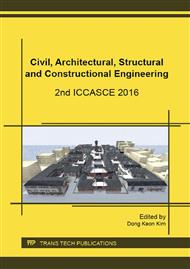p.157
p.163
p.173
p.179
p.184
p.190
p.196
p.202
p.208
Influence of Pro-Coating Coarse Aggregate on Engineering Properties of Recycled Concrete
Abstract:
This study is aimed to investigate the effects of four kinds of pro-coating coarse aggregate included air-dried condition, 50 degrees Celsius curing for 24 hours, saturated lime water curing for 28 days and original recycled aggregate for a comparison group. Performance testing included slump, compressive strength, ultrasonic velocity, absorption and resistivity tests and were evaluated the fresh, mechanical and durability properties. Test results indicated that the specimens containing four kinds of recycled aggregates performed batter workability due to the smooth surface pro-coated with slag. The specimens containing pro-coating aggregate with 50 degrees Celsius curing had lower absorption, higher compressive strength, ultrasound velocity and resistivity than others due to the better denseness and compactness. At the age of 28 days, the recycled aggregates specimens with 50 degrees curing had 22 % higher compressive strength and 40 % lower absorption than the original recycled aggregate specimens. For engineering requirements, pro-coating technology should be applied to improve the engineered properties of concrete and promote the natural resources recycling technology.
Info:
Periodical:
Pages:
184-189
Citation:
Online since:
November 2016
Authors:
Price:
Сopyright:
© 2017 Trans Tech Publications Ltd. All Rights Reserved
Share:
Citation:


